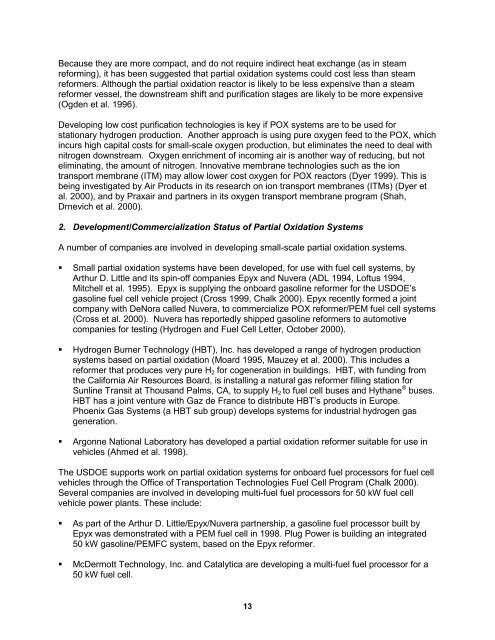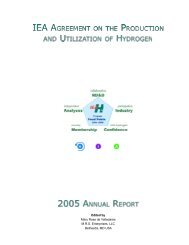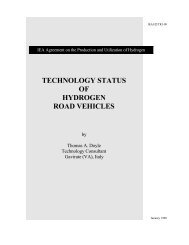Review of Small Stationary Reformers for Hydrogen Production
Review of Small Stationary Reformers for Hydrogen Production
Review of Small Stationary Reformers for Hydrogen Production
Create successful ePaper yourself
Turn your PDF publications into a flip-book with our unique Google optimized e-Paper software.
Because they are more compact, and do not require indirect heat exchange (as in steam<br />
re<strong>for</strong>ming), it has been suggested that partial oxidation systems could cost less than steam<br />
re<strong>for</strong>mers. Although the partial oxidation reactor is likely to be less expensive than a steam<br />
re<strong>for</strong>mer vessel, the downstream shift and purification stages are likely to be more expensive<br />
(Ogden et al. 1996).<br />
Developing low cost purification technologies is key if POX systems are to be used <strong>for</strong><br />
stationary hydrogen production. Another approach is using pure oxygen feed to the POX, which<br />
incurs high capital costs <strong>for</strong> small-scale oxygen production, but eliminates the need to deal with<br />
nitrogen downstream. Oxygen enrichment <strong>of</strong> incoming air is another way <strong>of</strong> reducing, but not<br />
eliminating, the amount <strong>of</strong> nitrogen. Innovative membrane technologies such as the ion<br />
transport membrane (ITM) may allow lower cost oxygen <strong>for</strong> POX reactors (Dyer 1999). This is<br />
being investigated by Air Products in its research on ion transport membranes (ITMs) (Dyer et<br />
al. 2000), and by Praxair and partners in its oxygen transport membrane program (Shah,<br />
Drnevich et al. 2000).<br />
2. Development/Commercialization Status <strong>of</strong> Partial Oxidation Systems<br />
A number <strong>of</strong> companies are involved in developing small-scale partial oxidation systems.<br />
� <strong>Small</strong> partial oxidation systems have been developed, <strong>for</strong> use with fuel cell systems, by<br />
Arthur D. Little and its spin-<strong>of</strong>f companies Epyx and Nuvera (ADL 1994, L<strong>of</strong>tus 1994,<br />
Mitchell et al. 1995). Epyx is supplying the onboard gasoline re<strong>for</strong>mer <strong>for</strong> the USDOE’s<br />
gasoline fuel cell vehicle project (Cross 1999, Chalk 2000). Epyx recently <strong>for</strong>med a joint<br />
company with DeNora called Nuvera, to commercialize POX re<strong>for</strong>mer/PEM fuel cell systems<br />
(Cross et al. 2000). Nuvera has reportedly shipped gasoline re<strong>for</strong>mers to automotive<br />
companies <strong>for</strong> testing (<strong>Hydrogen</strong> and Fuel Cell Letter, October 2000).<br />
� <strong>Hydrogen</strong> Burner Technology (HBT), Inc. has developed a range <strong>of</strong> hydrogen production<br />
systems based on partial oxidation (Moard 1995, Mauzey et al. 2000). This includes a<br />
re<strong>for</strong>mer that produces very pure H2 <strong>for</strong> cogeneration in buildings. HBT, with funding from<br />
the Cali<strong>for</strong>nia Air Resources Board, is installing a natural gas re<strong>for</strong>mer filling station <strong>for</strong><br />
Sunline Transit at Thousand Palms, CA, to supply H2 to fuel cell buses and Hythane ® buses.<br />
HBT has a joint venture with Gaz de France to distribute HBT’s products in Europe.<br />
Phoenix Gas Systems (a HBT sub group) develops systems <strong>for</strong> industrial hydrogen gas<br />
generation.<br />
� Argonne National Laboratory has developed a partial oxidation re<strong>for</strong>mer suitable <strong>for</strong> use in<br />
vehicles (Ahmed et al. 1998).<br />
The USDOE supports work on partial oxidation systems <strong>for</strong> onboard fuel processors <strong>for</strong> fuel cell<br />
vehicles through the Office <strong>of</strong> Transportation Technologies Fuel Cell Program (Chalk 2000).<br />
Several companies are involved in developing multi-fuel fuel processors <strong>for</strong> 50 kW fuel cell<br />
vehicle power plants. These include:<br />
� As part <strong>of</strong> the Arthur D. Little/Epyx/Nuvera partnership, a gasoline fuel processor built by<br />
Epyx was demonstrated with a PEM fuel cell in 1998. Plug Power is building an integrated<br />
50 kW gasoline/PEMFC system, based on the Epyx re<strong>for</strong>mer.<br />
� McDermott Technology, Inc. and Catalytica are developing a multi-fuel fuel processor <strong>for</strong> a<br />
50 kW fuel cell.<br />
13













